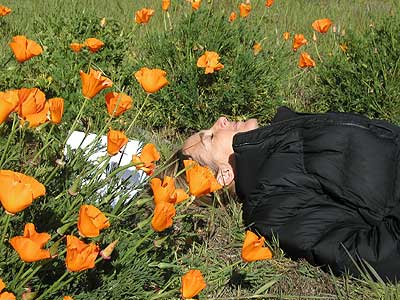
Permaculture is
the practice of observing Nature
and then applying her solutions
to human designs.
the practice of observing Nature
and then applying her solutions
to human designs.
Permaculture's root is "Permanent agriculture." It's an idea birthed 30 years ago by two Australians: Bill Mollison who made his living as a logger (until he lived in the forest and had a nervous breakdown when he saw how perfect the forest system already was) and David Holmgren, an academian who has been steadily inventing permaculture on his own homestead every since.
It's been a rural ecology sort of thing up until very recently. Right now is the first page of the chapter on Urban Permaculture, when we discover how deep ecology principles apply to our urbanscape.
So even though I lead the post off with a "definition," Permaculture includes dynamic change (it's modeled after Nature, afterall!) and so as it evolves, other definitions will become known.
 Sun melts self into self
Sun melts self into selfWind stirs and stimulates
Generator in the tower sings
Flight sounds roll like thunder
Synthetic vibrations irritate while
Earth's vibrations soothe me
Today I learned about Zones and Sectors, as well as Patterns, Functional Analysis and Whole System Theory. Zones are the energetic forces we can control, and Sectors are those we cannot. Zones are divided up by frequency of use; Zone 0 can be my own body (I use it all the time), Zone 1 where I go many times a day, on out to Zone 5, which would be the wild places.
Sectors are energies we do not control: the sun and wind are sectors in a rural setting, while in an urban environment we could add noise, traffic and crime. The effect of a sector can be modified; we can open up to it, we could deflect it, or we could transform it. How do you transform that which you do not control? Ah, grasshopper, when you answer that koan you can teach permaculture.
The course appears to embody a deep ecology frame, rather than an environmental frame. Environmentalists strive to save the earth; but they do so from the outside, as "saviors," as separate from the Natrual world. I personally know several environmentalists who are really screwed up in their own hearts; from where does their power to heal anything spring? They are burned out and frustrated, tilting at windmills.
A deep ecologist knows humans are part of Nature, and so to heal ourselves first is to heal the earth. In actuality, most earth-workers oscillate between these two places of action, but I find myself far more aligned with the deep ecology view. Not bad for a Roman Catholic, eh? It's certainly part of my faith's mystic roots, so it's less contradictory than you might think.
In any case, when we are learning about patterns, it feels very natural to me as we use kinesthetics to explore. From Fibonacci spirals to streamline meanders, from fractals to crenulation, the patterns of Nature resonate in our beings. If we use these patterns when we design, the design is far more adaptable and sustainable.
Sectors are energies we do not control: the sun and wind are sectors in a rural setting, while in an urban environment we could add noise, traffic and crime. The effect of a sector can be modified; we can open up to it, we could deflect it, or we could transform it. How do you transform that which you do not control? Ah, grasshopper, when you answer that koan you can teach permaculture.
The course appears to embody a deep ecology frame, rather than an environmental frame. Environmentalists strive to save the earth; but they do so from the outside, as "saviors," as separate from the Natrual world. I personally know several environmentalists who are really screwed up in their own hearts; from where does their power to heal anything spring? They are burned out and frustrated, tilting at windmills.
A deep ecologist knows humans are part of Nature, and so to heal ourselves first is to heal the earth. In actuality, most earth-workers oscillate between these two places of action, but I find myself far more aligned with the deep ecology view. Not bad for a Roman Catholic, eh? It's certainly part of my faith's mystic roots, so it's less contradictory than you might think.
In any case, when we are learning about patterns, it feels very natural to me as we use kinesthetics to explore. From Fibonacci spirals to streamline meanders, from fractals to crenulation, the patterns of Nature resonate in our beings. If we use these patterns when we design, the design is far more adaptable and sustainable.
 "Permies" model a radial pattern
"Permies" model a radial pattern Permies model a crenulation pattern.
Permies model a crenulation pattern.I am so tired after my first day of instruction and absorption that I'm not going to worry about anything I might have missed on my perfunctory proof-read of this post just now. I have to rest and get ready for tomorrow!
BTW the poem was written by a classmate, Corina. I also took the step of asking for and receiving the groups' permission to post their images.
BTW the poem was written by a classmate, Corina. I also took the step of asking for and receiving the groups' permission to post their images.

No comments:
Post a Comment